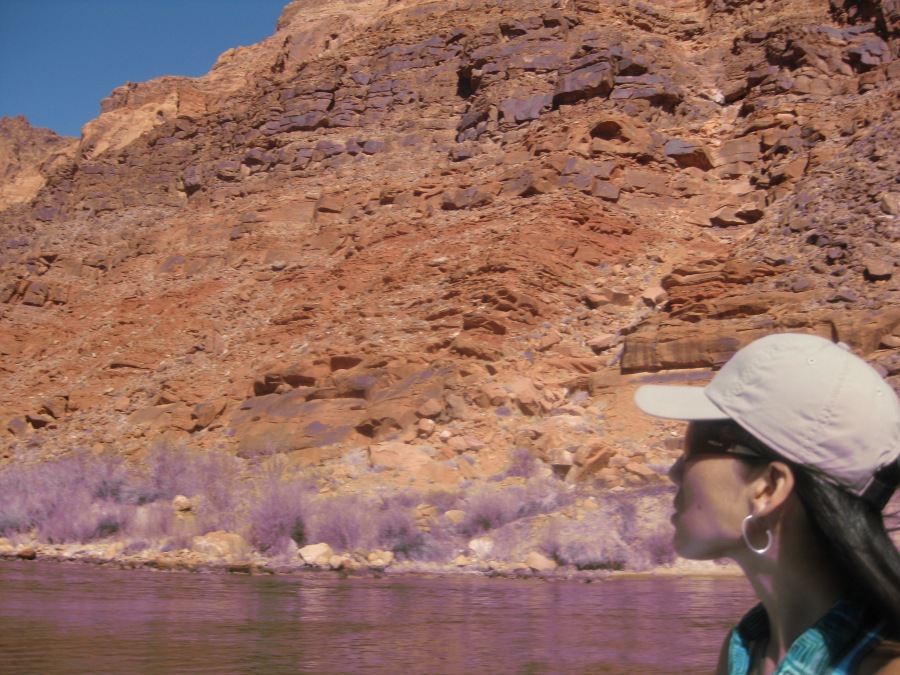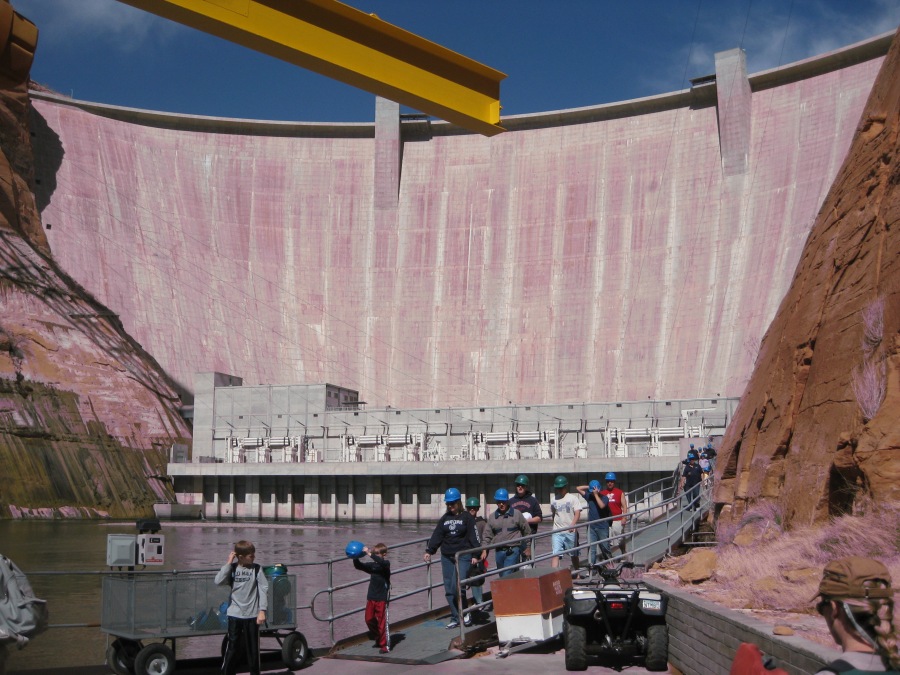Glen Canyon, AZ
While the far-reaching views from the South Rim of the Grand Canyon may be the most enigmatic and spectacular, there is a particularly intimate magic to being inside the canyon itself. One cannot really know the place without being underneath its shadowy depths. But there’s a rub…there’s still no easy way into the canyon.
The advent of touristy helicopter excursions out of Las Vegas have however made it much more doable, at least for those willing to pay.
We at BecauseItzThere recognize three legitimate ways to of descending into the Canyon to the banks of the mighty Colorado. The first two involve walking – either under your own power, or having a mule do the walking for you. These are the only B.I.T. sanctioned means of getting from the rim to the bottom of the canyon, in our humble opinion.
(Note that falling, while perhaps the most rapid way, is neither sanctioned nor recommended.)
There is a third sanctioned way in, and this is perhaps the most direct way. That is to enter through the Grand Canyon’s Grand front door. Meaning, the river itself…rafting on the wild Colorado.

And the riparian way is perhaps the most challenging of all. Though much of the Colorado River flows gently through the canyon bottom, there are places where the water is anything but gentle. In fact, if one floats the entire 280-mile (that’s right, two hundred eighty miles!) of Canyon between Lakes Powell and Meade, by Brian’s count you will pass 45 or more rapids of class four or greater.
Here’s an example of what the worst of it is like…
Some of these rapids are among the most notorious sections of whitewater in the entire United States, accountable for numerous fatalities. Though professionally outfitted guide services have made rafting the Colorado much safer than it was in the days When John Wesley Powell and his crew first explored the river in wooden boats, the Grand Canyon today remains a demanding whitewater gauntlet that should only be attempted by very experienced rafters, or people who have hired competent professionals to get them safely through.
It is nonetheless gauntlet of spectacular thrills that some 22,000 visitors annually will attempt, and accidents these days are in fact rare. While standing on the rim, Sylvia and I did see a few of the modern style expedition rafts plying their way down the river. It was tempting to imagine ourselves in one of them.

Though it is possible to run the canyon privately, Federal authorities sharply limit the number of permits given out, and the wait time for such expeditions is currently over a decade. Since the canyon is not a place for inexperienced rafters anyway, most simply hire on with a guide. Commercial river adventures are easy to come by and range anywhere from eighteen days for the full canyon traverse to single day highlight runs.
Sylvia and Brian wanted to see some of the interior of the canyon right from the water level. (The closest Brian had previously come was to cross the Colorado on the suspension footbridge near Phantom Ranch.) But to do so would have been almost a logistical impossibility given our time and budget. Plus, Brian is a rather notorious USO (Unqualified Sinking Object) and did not feel himself up to par for a demanding trip downriver in a raft, which he would likely be clinging to for his life, very soon after getting treatment for a herniated back.
Happily, we discovered a compromise. There are no shortage of commercial rafting trips that leave right from the Glen Canyon Dam and put back in at Lee’s Ferry – the beginning point of the Grand Canyon expeditions. This allows for a complete tour of the almost equally remarkable stretch of the Colorado that flows through Glen Canyon.

Much of Glen Canyon – the parts of its behind the dam – are now underwater, sitting at the bottom of Lake Powell. But the section downstream of the dam, which includes famed Horseshoe Bend, are a red-rockers paradise. There is no whitewater on this section (unless the damn’s spillways are open, in which case you won’t be rafting anyway.) Even the most faint-hearted boater will find nothing disagreeable on this placid and scenic half-day trip.

The trip begins in the shadow of the Glen Canyon Dam. Still a controversial and impressive monstrosity to this day, the dam looms over the canyon and is in fact the entire reason for the town of Page being here at all. When completed in 1963, the 710-foot-high concrete structure was one of the largest and most ambitious dams in the world, ranking just behind the larger and more famous Hoover damn some 300 miles further downstream.
To reach the raft put in, the bus actually travels down a tunnel drilled into the rock during the construction of the dam.
Environmentalists, politicians and scientists continue to argue to this day about the costs and benefits of the dam. An interesting footnote to the debate is that for all the clean power it supposedly produces, the huge coal-fired power plant located next to it actually produces far more energy, and its impact on the land is arguably far less. A much better argument for the dam might be the more than two million people that visit Lake Powell each year for the purposes of recreation – one third the number that visit the Grand Canyon – and the immense revenue they generate.
Another point of interest is the Glen Canyon Dam Bridge adjacent to the dam, which was the highest bridge in the US when it opened in 1957. US 89 still crosses on the original 700-foot-high, thousand foot wide span.
While not nearly as deep as its Grand cousin, Glen Canyon is famous for its shear red rock walls, some nearly a thousand feet high. This, too, would have been underwater had the proposed Marble Canyon Dam been built, but opposition from environment groups derailed that project, saving this and likely the Grand Canyon too from perhaps irreversible damage.
From the dam – where we boarded in hard hats, as per the requirements of the site — Sylvia and I drifted placidly down this river with the tour group. Lemonade, chilled by the waters of the Colorado, was served en route as a refreshment.





Parts of Glen Canyon may be familiar from the movie ‘Into the Wild.’ It is the Colorado that Chris McCandless, played in the movie by Emile Hirsch, paddles down in an effort to reach the Sea of Cortez. Some of the canyon scenes were filmed in Glen Canyon, and the guide delighted in pointing out many of the places that feature in the movie, including a small spring the main character drinks from.

Another interesting feature of Glen Canyon is the Native American petroglyphs that were carved right into the native rock. We saw this one at a rest stop…what was the artist trying to communicate here? Was this in fact even art, or was it more like a road sign? Did this mean it was a good spot for hunting? Did it have a purely spiritual significance? As we do on the canyon rim itself, we can only stand at our edge of time and ponder across the ages.


Sylvia and I would absolutely recommend the half day tour, which only takes a few hours and is scenically pleasing from start to finish. Brian dug up his old notes from the trip…we went with Colorado River Discovery and had a very good experience, but there are many other outfitters who do half and full day trips.
Another thing to consider is a stop at Horsehoe Bend on the way in or out. You have probably seen about a thousand version of this picture…

That’s Horsehoe Bend. It takes about an hour to do the 1.5 mile trip to the edge of the canyon and visit this remarkable place. We passed the trail head on the road and later drifted through it on the raft. We’ll have to save the view above for a later trip.
If you have the time and feel up to it, strongly consider a rafting trip down the canyon itself. It’s a once in a lifetime excursion that few will ever do. In his life Brian has only met one or two people who have ever done the complete eighteen-day traverse, and he envies them greatly.

If you can’t, well that’s okay. Do a shorter tour…or spend a relaxing day on the waters of Glen Canyon and enjoy its many pleasures. You can also take in nearby Antelope Canyon, only of the most weirdly photographic places in America…or continue North on US 89 to the Four Corners. There’s no end to the amount you can do and see here.
But if you are not up to rafting, there’s always the option of walking down into it…and indeed, across it from one side to the other. As Brian did.

Next Up, we’ll take a brief break from the Grand Canyon to visit a local attraction — Medoc Mountain State Park. We’ll return to the Grand Canyon to recap Brian’s 2003 Bucketlist North-South Traverse.